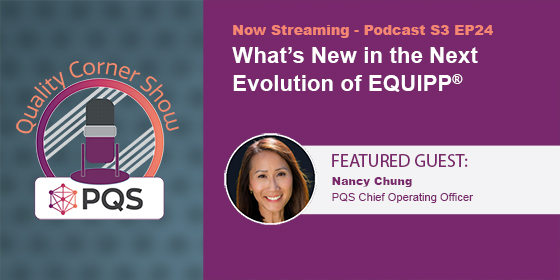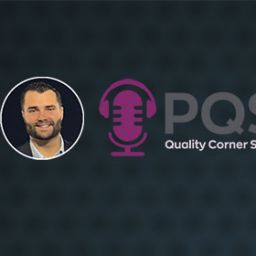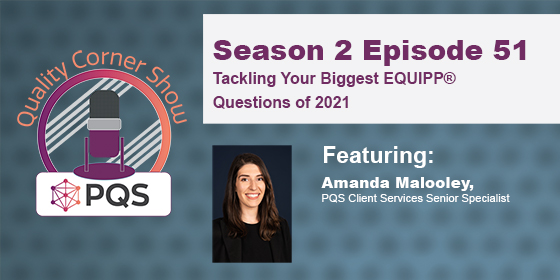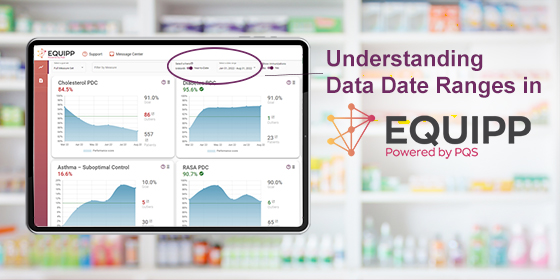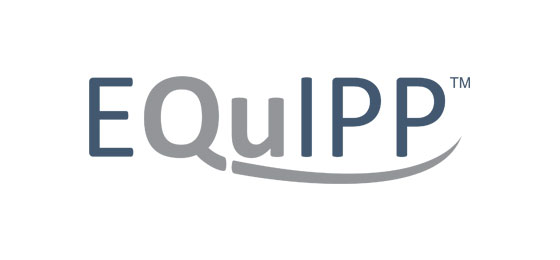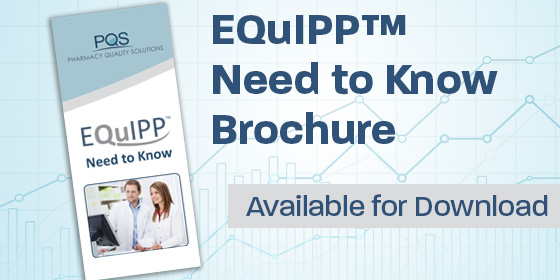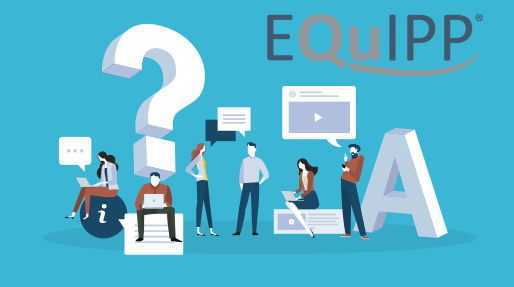
 PQS is pleased to have received some great questions from attendees during Q&A sessions of our recent EQuIPP® webinars. In season 2 episode 32 of the Quality Corner podcast, PQS Senior Manager, Pharmacy Accounts, Nick Dorich, PharmD, answers a few of these questions as posed by PQS Communications Specialist David Simoneaux.
PQS is pleased to have received some great questions from attendees during Q&A sessions of our recent EQuIPP® webinars. In season 2 episode 32 of the Quality Corner podcast, PQS Senior Manager, Pharmacy Accounts, Nick Dorich, PharmD, answers a few of these questions as posed by PQS Communications Specialist David Simoneaux.
As a cheat sheet to this podcast, we have transcribed the Q&A section of that episode below as a quick guide for you the listener.
Below are timestamped questions from the podcast (which is embedded in the player at the bottom of this page).
4:07 mark
Question 1: Does PQS maintain and provide a list of products by GPI or NDC that are used in the various PDC calculations?
Dorich: We do! We take several steps to source GPI and NDC data from the industry and perform a rigorous QA process on that data monthly which is used in the performance measure calculation process. We also use the monthly NDC lists provided by the measure endorsers like the Pharmacy Quality Alliance (PQA) as well. Since many of the measures we track are chock full of generic products and older medications, many of the NDC updates are really just new forms of packaging or from a new generic manufacturer. For the measures you see in EQuIPP® today, there are very few “new” medications, except for maybe with the specialty pharmacy measures that some pharmacies may have available.
Simoneaux: Is this list accessible to EQuIPP® end users or is that list available upon request? How does that work?
Dorich: That’s a great question. The measures that pharmacists or end users see in EQuIPP® are typically licensed from a measure developer like PQA or National Committee of Quality Assurance (NCQA). There may be some exceptions, but that is generally the rule. Because of that, we are licensing those measures from the groups, and we have to direct users to those measure developers for specifics on the exact medication lists. However, I would recommend checking out the Resources and FAQ tabs in EQuIPP®. These will include some measure one pagers or overviews which cover the measures, what they calculate, how they are calculated, and they’re typically going to include the medication classes that are included for the measures. That is an important call out, while it may not be the NDC or GPI list exactly, a pharmacist should be able to identify based upon that listing of the classes of medication that are included, they should be able to identify those medications in the patient profile. An easy example would be covering the RASA PDC measure, where we can identify this measure covers ACE inhibitors, Angiotensin 2 receptor blockers and direct renin inhibitors. With these measure descriptions, it gives your pharmacy team enough information to conduct effective patient follow up, as you’re reviewing the patient profile, or having a conversation with the patient directly.
6:43 mark
Simoneaux: Ok let’s move on to Question 2: I believe this next question deals with PDC calculation.
It reads “Can you explain the numerator of the PDC, and the overlap exception?”
Dorich: This is a popular question, and it came through on the webinar, but one when we have typically been out on tradeshows or having meetings or consults with pharmacies, this is one of the most frequent questions we are asked. I am happy to share about it here! The key details for a PDC calculation are that a day of a fill only counts as 1 day. There’s no overlap, and overlap can’t be counted, and you can’t have a patient that has more than 100% as their PDC. So, if a patient fills a prescription early… that’s fine from a measure calculation standpoint. Your pharmacy is not penalized for that, those days are going to be counted eventually. However, for the purpose of a calculation, that new prescription fill officially starts on the first day not covered by a current fill of a prescription. So, I’ll put this in some simple terms: there is no overlap. In addition, the days covered only go until the end of the measurement period. For example, if a patient fills a 30-day prescription on June 23 and the measurement period goes until June 30th, that fill is only counting for 8 days, from June 23 to June 30. Again, we are only measuring to June 30. However, when that measurement period extends into July for the calendar year, those additional 22 days from that 30-day fill will be captured!
So, the key points here that I would make for the pharmacists: there is no overlap, and early fills are just going to be counted for the period after the last fill of the prior medication.
Simoneaux: And I’ll add that we do have a video in the EQuIPP® Educational library on our website and on youtube about “Calculating Medication Adherence Based on Proportion of Days Covered” if that helps our listeners. Next, let’s transition to Question 3:
8:35 mark
“Concerning high risk medications– How do we know what you are targeting- some profiles may have multiple depending on what recommendations/guidelines you look at?” Can you further explain this?
Dorich: Absolutely, for this measure, I would recommend pharmacists look at the HRM measure resource and description that is on the Resource or FAQ tab in EQuIPP®. It will give a listing of the medication or medication classes that are included. I would note that this is based off on the Beers list criteria that is updated by the American Geriatric Society, but it is not a 1:1 for that listing. That’s an important distinction. For the measure calculation itself, this measure identifies patients that may have 2 or more fills of a medication or medications that could be inappropriate for a patient over the age of 65. Because of this, the pharmacist and their team should review all the medications on the patient’s profile that fall into this measure category. Like other measures that we described above, there are some one-pagers are going to identify those classes and medications, so that’s your best source. To address the patients in this measure a pharmacist would need to work with the patient’s appropriate prescriber, so they do not have 2 or more fills for ANY of the medications included. That’s a long-winded response, so I will quickly summarize – this measure could have multiple medications for which the patient is flagged, so the pharmacist should review the patient’s entire medication profile to address this measure.
10:09 mark
Simoneaux: Alright. Next Question: Do display measures also show on the dashboard, or are all of the measures displayed quote “real” unquote measures? Maybe this question is trying to address star ratings? Nick, what’s your take?
Dorich: First of all, this is a great question and I really appreciate the pharmacist or pharmacy team member that submitted it! It shows a great nuance or understanding that some measures are included in the Star Ratings, others may be display measures hosted by Center for Medicare and Medicaid Services (CMS), and other measures may not be used in the Star Ratings at all! So, are these measures, are they real or are they not real? The measures are real. But they may be used in different programs or with different intent. And that is exactly the case! EQuIPP® hosts over 20 different measures in the dashboard today. Now most pharmacies or pharmacists aren’t going to see all 20+ measures in their dashboard. It’s dependent on the managed care organizations that have data for that pharmacy and what measures they are tracking. So most pharmacies are probably seeing about 6 to 10 measures in their dashboard. For these measures, some of these will extend beyond what is included in the Medicare Star Ratings program today and even beyond the display measures that CMS hosts.
When I am consulting a pharmacy about how to understand and prioritize their analysis of data in EQuIPP®, I always start with having them identify the measures that are pertinent to performance programs that they are enrolled in today. Start with focusing on those measures is going to be key for a pharmacist to have the impact that is meaningful for their location. But, I would add, don’t lose sight of other measures in your dashboard! If a managed care organization is looking at performance for one measure here and now, it might not be part of a performance program today or this calendar year, but it may be a good sign that it could be included for different forms of performance programs in the future. So to summarize and a nice soundbite for everyone involved: pharmacists should take a look at the measures included in their performance programs, and then any additional measures should be their secondary or tertiary options for priority.
12:25 mark
Simoneaux: Ok, final question for today’s show. “If I don’t have “My Programs”, can I still see payer data for my pharmacy?”
Dorich: Yes, from my standpoint, understanding where to find the payer data or payer specific performance in EQuIPP® that is specific for your pharmacy is actually, the most important thing to do when reviewing EQuIPP®! If you did not attend the webinar, Amanda did a great job of explaining this. Make sure you attend future webinars because I expect we’ll cover more of this topic in the future.
The My Programs tab in EQuIPP® is a good place to start, if it is available to your pharmacy. For these instances, payers may display via EQuIPP® specific target thresholds and/or financial impact for a pharmacy based on the program design. Ultimately, this makes it very simple for a pharmacy to understand what they need to do and what patients should be prioritized!
For other situations, your pharmacy team can click the “Analyze Performance” button shown beneath each measure, and then view the “Quality Improvement Programs” (QIP) table. Here, it shows your patient count, performance score and percentile for each payer program. Many programs are shifting to evaluation based on percentile rank, which really means its identifying what percentage of pharmacies you score better than in that program. For example, if your pharmacy is showing at the 35th percentile, that means your score is better than 35% of pharmacies in that program. That really becomes a clear way to identify where your performance is relative to other pharmacies and given that again, many payers are moving to that form of program, that can be an area that helps your pharmacy prioritize actions and follow up steps.
14:22 mark
Simoneaux: Nick, thank you for taking the time to answer these questions. These were indeed some great questions from our webinar attendees that show pharmacies out there are wanting to engage more with the EQuIPP® platform, increase their level of understanding of EQuIPP®, and in return help their overall care of their patients.
Should an EQuIPP® user have other questions, how can they reach out to PQS?
Dorich: We do love to hear from pharmacies, and quality measures can be confusing. I went to pharmacy school and graduated 10 years ago. Quality measures were a new concept even at that point, and I expect that folks will have a lot of questions. We want to help answer those questions as effectively and easily as possible. Before I get into the specifics on how to contact us, make sure to check out the resources page and review the measure one-pagers. They are very quick and easy ways to understand the measures. Check out the FAQ page in EQuIPP®, and go to our YouTube page at https://www.youtube.com/PQSEQuIPP. There are short videos there, about 3 to 5 minutes. We have about 20 videos there, Be sure to go through that content, it’s a great way to learn. You can always email support@equipp.org, but we recommend filing a support ticket within the EQuIPP® platform. You can tap the blue Support widget button in the bottom right corner on the EQuIPP® homepage or the smaller support link in the top right corner. From there you can go through our support ticket system to contact one of our representatives.






